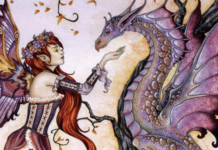
Artist Spotlight is rather new, like my column. I will be shining a light on various artists at least once every few months. I must confess, I write these not only to bring attention to artists that I feel are making a mark on the world, but because I want to learn more about them.
It’s no secret that I’m not a formally trained artist — but neither was Vincent Van Gogh. Not that I’m anywhere near his league, but there’s hope for me and all the other self-taught artists in the world! We learn best from other people, and today the spotlight is shining on Tommie Kelly, the creator of the Forty Servants oracle deck and author of the Forty Servants Grimoire. Tommie is an incredible illustrator, an accomplished magician, and a successful writer (so my hero, pretty much).
I’ve had the honour of speaking with Tommie on several occasions via social media and email, so conveniently the interview is all in writing, eradicating the risk of misquoting that a spoken interview carries. Nothing makes me switch websites or turn a page faster than a Q&A style article, where the interview is transcribed onto the page. I will supply quotes from the interview, but my readers mean too much to me to offer them a cut and paste article.
If you feel that I left something out just contact me using one of my social media links, or you can contact Tommie Kelly himself, as his contact information is provided below.
Artist profile
Tommie Kelly is a self-taught artist who lives in Ireland. He explored a variety of mediums through which to express his creativity and found his niche in digital illustration. There is an old adage that says “the tool doesn’t make the artist,” but in this case it did!
I certainly agree — the mediums with which I work are an extension of me, while several mediums I’ve tried made me feel clumsy and dull. My perfect tools are oil paints and bristle brushes, and Tommie’s perfect tool is the digital paintbrush. He says,
I spent a lot of time trying out different techniques and processes and nothing ever clicked. I never found that a tool made my art any better or closer to what I wanted it to be. But then I went digital — and it all completely and almost instantly fell into place.
With the help of YouTube tutorials, art books, online courses, and seeking advice from other artists, Tommie honed his skills. He had pointed out that a self-taught artist often “conjures images of a lonely figure sitting in a room trying to find the secrets of art by himself but that’s not really the reality of it.” Like myself, and many aspiring artists of today’s world, self-instruction means finding free tutorial videos, step-by-step infographics, and enrolling in free classes on a MOOC (Massive Open Online Courses) website.
Utilizing the free resources the Internet has to offer was certainly a wise choice, and the beautiful images on the Forty Servants cards are proof.
Tommie’s original intention behind learning digital illustration techniques was to create comics or graphic novels. While his comics haven’t been commercially successful, they still changed his life for the better. If he hadn’t set out to create comics, he wouldn’t have been visited by Creativity and gifted the inspiration to create the servitors. Ever since I read Elizabeth Gilbert’s book Big Magic, I can’t help but think of inspiration as something thrust upon us by Creativity, a unique type of force that exists in the universe. This idea has once again been reinforced by Tommie’s experience in creating the servitors. As he says, he
…just allow the art to manifest in the way it wants to rather than forcing your stamp or rules or needs onto it. It’s kind of like CHANNELLING (in the spiritual sense) but it’s not that either. I don’t think I am communication with a higher being or anything like that — more just to let the ideas flow from wherever ideas flow from rather than force them into some shape that they don’t want to be. I am fascinated by the notion that is not that people have ideas but that ideas have people…

From Buddhist tourist to chaos magician
Tommie has had a diverse exposure to magick, starting at an early age of 13 or 14 reading Stuart Wilde, Alice Bailey and other New Age material. By his early twenties he had moved on to Alan Watts and Aleister Crowley. He spent some time studying Buddhism as well, saying, “I was never an actual Buddhist. More a Buddhist tourist.”
Tommie went to college in his mid-20s to study holistic health, becoming qualified in aromatherapy, reflexology, Indian head massage, and reiki. While he loved learning about it, he never felt a calling to go into a career as a healer. That call came later, when he watched the “internet-famous Grant Morrison speech for the Disinfo conference from around the [turn of the] millennium. It was my first exposure to chaos magick — and it really felt like coming home in a way. All of my disparate ideas about life, the Universe, and everything after, all fitted nicely into the chaos magick paradigm.”
He has been a chaos magician ever since. Chaos magick, according to Tommie, emphasizes the “attainment of results by finding and utilizing techniques that actually work over conforming to strict occult tradition or process.” Beliefs are seen as tools to be used “rather than patterns or programs to be lead by. It suggests that no truth is absolute, or even truly knowable, and so prefers to see all truth as ultimately subjective.”
Related: What is chaos magick?
Related: Top 5 chaos magick books, by Psyche
Related: Chaos magick: Doing what works and more, by Psyche
Thoughtforms and tulpas and egregores, oh my!
Please forgive me, I couldn’t resist. So, before going into what the Forty Servants are, I thought it would be helpful to understand what they are not. Now, they could be the foundation for tulpas or thoughtforms, but that is up to the person who possesses the cards. More about that later.
A thoughtform is a creation of the human mind. Thoughts are immensely powerful, so powerful that the Tibetan Buddhist tradition the Diamond Way teaches that reality is the creation of human thought.1 Thoughtforms are entirely dependent on their creator – if you don’t “feed” them energetically, they cease to exist.
According to Rev. Duncan, a tulpa is created with conscious intention, that is, they are thoughtforms created by focusing on a single thought and infusing the thought with intense emotions. The concept of tulpas originates from the Tibetan Buddhism and Bon religions. These traditions define tulpas as consciously created beings or objects.
Rob Schwarz, a contributor to the Stranger Dimensions website, says that egregores are thoughtforms manifested by a group consciousness “which can become powerful enough to take on a life of its own. It becomes driven by the collective (and often unintentional) willpower of large numbers of people.” So, bigfoot, the kraken, and monsters of myths and legends could become real if enough people truly believe in them. Schwarz states that egregores “don’t need to be “conjured.” They can manifest over time through sheer awareness and acknowledgement by large groups of people. You need not be consciously aware to participate in the creation of an egregore.”2 That’s not scary or anything!
Reated: Egregores: Notes on the role of the historical egregore in modern magick, by Frater U.’.D.’.
Related: Sigils, servitors and godforms: Part I, by Marik
Related: Sigils, servitors and godforms: Part II, by Marik
Related: Egregores, reviewed by Psyche

The Forty Servants
What are the Forty Servants? According to Tommie Kelly’s The Grimoire of the Forty Servants:3
At the outset I had a very definite answer to what the exact nature of the Servants was: “The Forty Servants are servitors;” but these days I am not so sure. These days it’s hard to pinpoint exactly what they are, and the more I try, the more I get the feeling that I am somehow missing the point, and in many ways I am only limiting them by trying…A servitor is commonly described as a thought-form. Personally though, I prefer to see a servitor as an idea. Servitors are created in order to FULFILL a particular purpose or perform a certain function. So in our case, each of The Forty Servants has been given a particular role, or power, so that they can be used to aid or guide you.
The way I would define them is that they stand for archetypes — the saint is not one particular entity, but the archetypal idea of what a saint is. The servitors may be used in any way the person wishes, so long as it adheres to the idea. For example, the Saint could not be used to hurt someone. The Protector, however, could be instructed to physically harm someone who tries to break into your home — or worse, if you so choose.
The Forty Servants do not necessarily have to become servitors to do your bidding. I use them for divination, and have been quite impressed with the results, considering I have not had much time to connect with them energetically.
Conclusion
Tommie Kelly is, as I said, an accomplished artist, successful writer, and an impressive magician. His “woo-woo,” as he calls it, is beyond impressive. The Forty Servants can attest to that. The work he put into them is unimaginable. Between that artwork and the magick, I don’t know what to be more amazed with!
When you get your deck there seems to be a tradition people have started: box burning. I prefer to upcycle my boxes, and put my cards in a handmade bag, but that’s up to you. I do, however, urge you to check out the Forty Servants.
If people want to try out the Servants for both divination and magick they can do so for free, including a free video course on YouTube. More information can be found on Kelly’s blog and podcast.
Image credit: “The Protector,”,”The Witch,” and “The Guru,” all by Tommie Kelly
- Rev. Gary Duncan, “Thoughtforms, Tulpas, and Egregores” New Dawn Magazine. [↩]
-
Rob Schwartz “On Egregores” Stranger Dimensions. March 25, 2013 [↩] - Tommie Kelly, The Grimoire of The Forty Servants: The Complete Guide to the Magick and Divination System (Tommie Kelly, 2017), 8. [↩]








